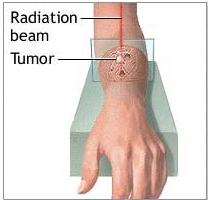방사선 치료는 암의 전이를 촉진시킬 수 있다. 
간암의 치료를 위하여 색전술을 해서 암세포를 죽이고 산소공급을 차단하기 위하여 혈관을 막아서 폐색시켜버린 결과 암세포들의 전이를 촉진시킨 결과를 초래하였다는 보고가 나왔다. 따라서 간암의 색전술 치료의 장래가 불투명해졌고 어떤 의사들은 색전술 치료를 사용하지 않기로 결정하고 있다.
그런데 최근에는 간암의 경우 방사선 치료를 했을 경우에도 역시 암세포들이 주위조직으로 침투해 들어가는 것을 촉진한다는 놀라운 사실이 밝혀졌다.
방사선에 의하여 죽지 않는 암세포들의 속에서 유전자 변이 현상이 일어나서 암이 더 빨리 공격적으로 퍼져나간다는 것이다.
현재로는 간암의 경우에 이러한 현상이 일어나고 있음을 알아냈지만 다른 암에도 적용될 수 있는 확률은 충분히 존재한다고 볼 수 있다.
사실 수술도 색전술의 경우처럼 혈관으로부터 산소공급을 차단시킨다.
그 이유는 수술 과정에서 많은 혈관을 잘라버리기 때문이다.
암에 칼을 대면 더 잘 퍼진다는 항간의 소문이 점점 과학적으로 증명되어가고 있는 것 같다. 하여튼 정상세포가 암세포로 변질되게한 생활 속의 문제점들을 제거하지 않은채 암세포에게 어떤 형태로던지 인위적으로 해를 가하면(항암치료의 경우) 암세포들은 자기들 나름대로 악착 같이 살 궁리를 한다는 증거들이라고 볼 수 있다. 그러다보면 더 공격적으로 변하고 잘 퍼지는 암세포가 되는 것이다.
결국 암의 궁극적 치료법은 뉴스타트로 생활의 개혁을 일으켜야만 한다.
이 생활의 개혁은 생각의 개혁이 있어야만 가능하다,
그러면 암세포들은 스스로 T-임파구에게 자기를 죽여 달라고 찾아온다고 한다.
그리고 암세포는 B7이라는 물질을 생산하여 T-임파구를 활성화시키어 자기를 죽이게 한다.
뉴스타트가 최종해결책인 것 같다.
다음은 방사선치료와 간암의 관계를 연구한 논문의 요약이다.
Radiation-enhanced hepatocellular carcinoma cell invasion with MMP-9 expression through PI3K/Akt/NF-![]() B signal transduction pathway
B signal transduction pathway
Oncogene (2006) 25, 7009–7018. doi:10.1038/sj.onc.1209706; published online 29 May 2006
J C-H Cheng1, C H Chou1, M L Kuo2 and C-Y Hsieh1,3
1. 1Department of Oncology, National Taiwan University Hospital and College of Medicine, Taipei, Taiwan
2. 2Laboratory of Molecular and Cellular Toxicology, Institute of Toxicology, National Taiwan University College of Medicine, Taipei, Taiwan
3. 3Department of Obstetrics and Gynecology, National Taiwan University Hospital and College of Medicine, Taipei, Taiwan
Correspondence: Dr C-Y Hsieh, Department of Obstetrics and Gynecology, National Taiwan University Hospital, No. 7 Chung-Shan South Road, Taipei 100, Taiwan. E-mail: cheng38@ms15.hinet.net
Received 19 September 2005; Revised 23 March 2006; Accepted 3 April 2006; Published online 29 May 2006.
Abstract
This study is to investigate the molecular mechanism of radiation-enhanced cell invasiveness of hepatocellular carcinoma (HCC) correlating with clinical patients undergoing radiotherapy and subsequently developing metastasis. Three HCC cell lines (HepG2, Hep3B and Huh7) and normal hepatocyte cell line (CL-48) were irradiated with different doses. The effect of radiation on cell invasiveness was determined using the Boyden chamber assay. Radiation-enhanced invasion capability was evident in HCC cells but not in normal hepatocytes. Invasion was observed in gelatin-coated but not fibronectin-coated or type I collagen-coated membranes. Radiation upregulated matrix metalloproteinase-9 (MMP-9) mRNA level, MMP-9 protein level and MMP-9 activity. MMP-9 antisense oligonucleotides inhibited radiation-induced MMP-9 expression and thereby significantly inhibited radiation-induced HCC invasion. Furthermore, phosphatidylinositol 3-kinase (PI3K)/Akt chemical inhibitors LY294002 and wortmannin suppressed radiation-induced MMP-9 mRNA expression. Transient transfection with dominant-negative Akt plasmid also showed that the PI3K/Akt-signaling pathway was involved in this radiation-induced MMP-9 expression. Moreover, nuclear factor-![]() B (NF-
B (NF-![]() B) decoy oligodeoxynucleotide suppressed radiation enhanced MMP-9 promoter activity completely. PI3K/Akt chemical inhibitors inhibited radiation-induced NF-
B) decoy oligodeoxynucleotide suppressed radiation enhanced MMP-9 promoter activity completely. PI3K/Akt chemical inhibitors inhibited radiation-induced NF-![]() B-driven luciferase promoter activity. Taken together, our results indicated that sublethal dose of radiation could enhance HCC cell invasiveness by MMP-9 expression through the PI3K/Akt/NF-
B-driven luciferase promoter activity. Taken together, our results indicated that sublethal dose of radiation could enhance HCC cell invasiveness by MMP-9 expression through the PI3K/Akt/NF-![]() B signal transduction pathway.
B signal transduction pathway.
Keywords:
radiation, hepatocellular carcinoma, invasion, signal transduction


 당뇨성 신부전증과 신장세포의 재생
당뇨성 신부전증과 신장세포의 재생
 [동영상] <합장> 77기 졸업 강의
[동영상] <합장> 77기 졸업 강의